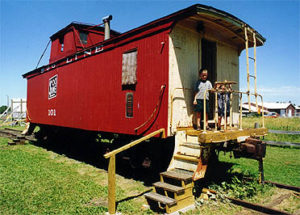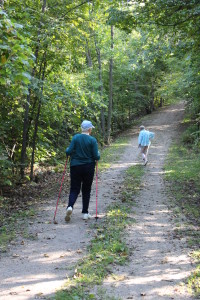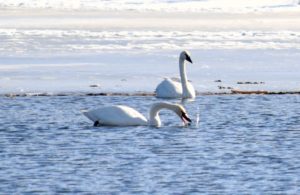Farmstead #4 – YMCA Day Camp
This farmstead is probably the most familiar to people who have visited the park or were associated with the YMCA. The farmhouse was the last surviving remnant of the nine farms that existed on the Bertram property until is was torn down in 2018. This house was the home residence for several of the YMCA caretakers who took care of the property from the early 1960’s until 2012 when the property was sold to the county and the city. For a couple of years, this farmstead property was the temporary sight of the YMCA Day Camp until the YMCA built their new facility.
It has been hard to locate names of past residents of the property due to the fact that it lies on the edge of two sections, #17 and #16. The first names to appear were in 1859 to William Parvin & John Parvin, possibly brothers or father & son since William’s name appears first on the Warranty Deed. Another name was Arnold & Helen Fernberg, 1901-1950.
As you may recall from an earlier tidbit, this farmstead has some national notoriety. Some time in the 1990’s, the well-known author Clive Cussler wrote a book entitled “Valhala Rising” about the Vikings in North America. It’s more of an adventure novel but it does touch on the history of the Vikings and a “possible” adventure to Minnesota. In the novel he mentions finding a rune stone on the shores of Bertram Lake in Monticello, MN. He mentions the old barn as being the working office of a historical researcher and tells of the land gently sloping to the lake.
The new chalet is part of this property, as well as the machine shed and garage built by the YMCA. This garage was built for the mini bike program created for troubled youth.
Farmstead #3 – Worthington/William Kiebel
This farmstead out of all the other eight farmsteads is probably the best known for many reasons. The farm buildings themselves were located atop the rise 1/8 mile above Bertram Lake. The site of the building was just west and east of the road leading to the current turnaround. It was just west of the new YMCA Day Camp, and consisted of a house, large barn, hen house, two machine sheds, and a grainery. The house was surrounded by lilacs and locust trees which are still there today. Access to the farm was a long driveway north to County Road 39.
As with Farmsteads #1 and #2, the land was originally granted to John D. Taylor in June, 1957. The current parcel was deeded to Daniel Worthington in 1877, then to his son in 1889. In 1901 William Kiebel began purchasing the land including the parcel at the north end of Long Lake (NW corner Section 16 and SW corner Section 9). This is where the new Long Lake overlook is located.
I mentioned earlier that this farmstead is probably the best known of the nine sites because of the historical importance. Below are a few reasons:
- This property provided the easiest access to Long Lake during the winter months. It was Long Lake that provided the purest water and thus the purest ice for the ice boxes of Monticello residents. Ice blocks were cut for many years there.
- The beach on Bertram Lake provided the only access for many years for fishing, swimming, camping and picnicking. Many parties and reunions occurred under the oaks at the beach. Prior to the 1851 land purchase, the beach area at Bertram was a stopover spot for Native Americans traveling through the area.
- Currently, as in the past, the land by the beach provides a crossroads for the bike and hiking trails, as well as other activities throughout the park.
Farmstead #2 – Outhoudt Family
The land for their homestead was originally included with the land granted in 1857 to John Taylor. Some of the notable owners of this farmstead include:
- 1870-1900: E.J. Beedy Family
- 1910-1945: Marcus Wildman Family
- 1945-1963: Lehigh Cement Co.
- 1963-2010: YMCA
The last known name associated with the farmstead was the Robert (Bob) Outhoudt Family. They did not own the land but they lived on the property. It’s possible they did some farming, maybe dairy and other animals, but in general the land was not very suitable for crop farming. The land was located off County Road 39 to the north and continued south to Mud Lake. East of the property the land was wooded and to the west the land abutted prairie/crop land.
The property itself was hilly with glacial depressions, not suitable for farming, dropping to the south to Mud Lake.
In the 1960’s, the YMCA planted pine trees on the land for potential sale as Christmas Trees in the Twin Cities area.
Farmstead #1 – The Wildman’s
Minnesota became a state on May 1, 1858, but the distribution of land began after the Traverse des Sioux Treaty of 1851. To facilitate this, counties were established as the population grew. Wright county was formed in 1855, and much of the land began to be distributed and recorded. Since Monticello was selected to be the county seat, as the most populous city, the land around it began to be distributed early. The nearest property of the Bertram Lakes land was along County Road 39 in the NE corner, Section 9, of Monticello Township.
The very first name on the abstract to be listed as the owner of the land was John Taylor, dated June 23, 1857. I will try to present owners every 25 years to show transfers of the land to other owners:
- 1884-1895:King Staples (interesting name)
- 1895-1905: Charles Beedy (wife, Sadie) during this time Sadie became the sole owner of the land, which was a rarity!
- 1910-1946: Marcus Wildman & Family
- 1945: Lehigh Cement Co.
In 1945, the Lehigh Portland Cement Co. granted a right of way to Standard Oil Co. to lay, maintain, inspect, operate, replace, change, or remove a pipeline for the transportation of gas and oil.
The last listing in the abstract shows a date of October 17, 1963, at which time the YMCA of New Hope became the owners. The Lehigh Portland Cement Co. placed a stipulation on the land that it be used in its natural setting and at the time it fit the YMCA’s vision as a day camp.
The farmstead (house, barn, siloh, etc.) existed on the rise about 1,000 feet south of County Road 39. The foundation of the barn still exists today, just north of Otter Creek which flowed through the property. The creek was the farm’s source of water until a well was drilled later.
Red Caboose? What Red Caboose?
 Someone recently asked me if there was a caboose (a red one) once located on the park property. I can say that yes, there was! Before I talk about this, though, I must first mention a little history.
Someone recently asked me if there was a caboose (a red one) once located on the park property. I can say that yes, there was! Before I talk about this, though, I must first mention a little history.
In railroad history, a caboose (usually red for a reason) was located at the end of all trains. It was the office and sleeping quarters for three of the railroad workers, one conductor, the brakeman and the flagman. All of these workers had very specific jobs designated by their names.
With the advancement of technology in the 1970’s, trains began braking and signaling electronically. in 1982, the Railway Labor Act directed railroads to begin eliminating the cabooses where possible to do so, but in the process it also eliminated jobs.
Still, the popularity of cabooses was very high and many people did not want to see them go to waste. The idea arose to put them in parks and playgrounds, whenever and wherever possible. Because of this, one was donated to the YMCA in the early 1980’s and placed near the old day camp facility of of 90th Street. It was located by the forked path that leads to the dam and the esker. A playground was located by it named Arrowhead Playground. The day camp kids loved it!
The question always arises, just how did it get there … but I can’t talk about that! As far as to where it went, it was donated to Pioneer Park in Annandale.
So yes, Virginia ~ there was a caboose at the park!
Going on a Nature Walk
Since we began this adventure in 2006, many people have stopped to tell me that they love to walk through the Bertram Lakes property. When asked to describe their experience in one word, they will say, “quiet, serene, beautiful, enjoyable, exercising, still, and renewing”. But … there are some rules to follow:
will say, “quiet, serene, beautiful, enjoyable, exercising, still, and renewing”. But … there are some rules to follow:
- Walk slowly.
- Spend 80% of the time looking up and around (unless you are looking for wildflowers or mushrooms).
- Open up all your senses, smell, see, hear, and feel what is being presented to you.
- Rest on a rock or stump and take in everything around you.
- Be aware of animals, birds, insects, trees, flowers, etc.
- Always check out something new.
There are many benefits to going on a walk through this beautiful property, some of which include:
- Relaxes the mind and body.
- Lowers stress, depression and anxiety.
- Increases attention span and memory.
- Provides exercise for the mind, body and spirit.
- Slows down our everyday pace.
- Gives us a peaceful feeling.
When going on a nature walk at Bertram park, here are just a few interesting things to look for:
- Glaciation: The park has three very special areas to be aware of,

- The “FEN”: A glacial lowland, a marsh located at the north end of Bertram Lake on the other side of the playground.
- The “KAME: A higher piece of land east of Long Lake. This is a perfect place to watch the emergence of the moon, planets and stars after sunset.
- The “ESKER”: Located between Long and Bertram Lakes, this high ridge of land is a perfect hiking area.
- Animal Life: Be aware of swans, loons, eagles, deer, beaver, and possibly river otter (for which Otter Creek is named).
- Flora: Trees of many varieties, wild flowers, mushrooms, etc.
Naturalist John Muir said it best, “in every walk with nature one receives more than he seeks”.
Whether it’s winter, spring, summer or fall, you’l always find something new to explore during your nature walks at Bertram!
Schools II
I have mentioned before that there were two country schools that serviced the students of the Bertram Lakes Area 125+ years ago. One was the Hanaford Country School which was located on Cahill Avenue, a fifth-mile south of County Road 106. This school was open from around 1870 to 1952. Then students began attending Oakwood School in Monticello. The Hanaford Country School was torn down some time in the 1970’s.
The second school was the Prairie West Country School located along County Road 39 West, approximately two miles from the I-94 underpass. The school met its demise on March 10, 2018. I wrote a letter to the editor of the Monticello Times which reads as follows:
These schools represent a time gone by, yet they also show that they were important in the development of the area.




